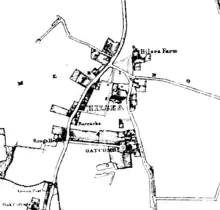Hilsea
Hilsea is a district of the city of Portsmouth in the English county of Hampshire. Hilsea is home to one of Portsmouth's main sports and leisure facilities – the Mountbatten centre. Trafalgar School (formerly the City of Portsmouth Boys' School) is also in Hilsea. It is also the home of Portsmouth rugby football club

| Hilsea | |
|---|---|
 Hilsea Lagoon footbridge | |
 Hilsea Location within Hampshire | |
| Population | 13,552 (2011 Census. Hilsea Ward)[1] |
| OS grid reference | SU663035 |
| Unitary authority | |
| Ceremonial county | |
| Region | |
| Country | England |
| Sovereign state | United Kingdom |
| Post town | Portsmouth |
| Postcode district | PO2, PO3 |
| Dialling code | 023 |
| Police | Hampshire |
| Fire | Hampshire |
| Ambulance | South Central |
| UK Parliament | |
Located at the northern end of Portsea Island, for most of its history Hilsea was a small hamlet on the Portsmouth to London road. The name "Hilsea" probably means 'holly island'.[2] The boundaries of Portsmouth were not extended to encompass the hamlet until 1832. The last working farm in Portsmouth, Green Farm, was located in the area up to the 1990s. This area is now a residential estate and is marked by a pub and hotel still known locally as the Green Farm, although its external sign bears only the name of the Toby Carvery chain which now owns it.
Construction of Hilsea Barracks started in 1780.[3] Over the decades they underwent various rebuildings and changes of use before being knocked down to allow for housing development in the 1960s.[4]
In the years after 1926 Hilsea expanded with the building of the Hilsea Crescent Estate which was constructed on former allotments.[5]
The north of the district composes the Hilsea Lines, former defensive fortifications that are now a nature reserve, known locally as Fox's Forest. In the 1930s western end of the line's moat became known as the Hilsea lagoon[6] and in the mid-1930s work was done on the banks and it was turned into a boating lake.[7][8] In the same period the land around the eastern end of the boating lake was converted into Hilsea bastion gardens.[9] Most of the gardens were destroyed as the result of road widening in 1968–70.[10] The terraces that formed part of the gardens were demolished in 2000.[9] In 1938 a bridge was built across the boating lake section of the moat.[11] It was demolished in 1999[11] and later replaced by the current structure.
The area is home to the Coach & Horses pub. This was originally the first public house reached when arriving on Portsea island from the mainland.[12] It was damaged in a fire in 1870 and had to be rebuilt.[12] It was again rebuilt between 1929 and 1931 to a design by A. E. Cogswell and this is the building that stands today.[13]
Another facility in the area was the Hilsea Lido which opened in July 1935.[14] It closed in 2008 although attempts are being made to reopen it.[15]
The north west of Hilsea is protected from the sea by Stamshaw Esplanade which was built between 1936 and 1938.[5][16] The Esplanade also serves to connect site of Hilsea lido with Alexandra Park[16]
Modern Hilsea is a mixture of residential and industrial areas. One of the major routes into Portsmouth still runs through the area. In addition, a small station serves the area. Also home to the world famous Brad Stares that stayed in Hilsea Crescent.
Portsmouth Airport & Anchorage Park
Between 1932–1973, the northeast corner of Hilsea was previously the location of Portsmouth Airport, and was one of the last remaining commercial grass runway airports in the United Kingdom.[17] The airport offered little scope for expansion and, following some accidents with larger aircraft in the 1960s, the airport was closed in 1973. During the 1980s, the former airport land was redeveloped into an industrial area and a housing estate now known as Anchorage Park.[18]
References
- "Portsmouth Ward population 2011". Retrieved 18 October 2015.
- "Hilsea Key to English Place-names". The University of Nottingham. Retrieved 25 December 2020.
- "Gatcombe House". British Listed Buildings. Retrieved 5 December 2016.
- Mitchell, Garry (1988). Hilsea Lines and Portsbridge. p. 30. ISBN 0-947605-06-1.
- Smith, Jane (2002). The book of Hilsea Gateway to Portsmouth. Halsgrove. p. 29. ISBN 1-84114-131-3.
- Smith, Jane (2002). The book of Hilsea Gateway to Portsmouth. Halsgrove. p. 34. ISBN 1-84114-131-3.
- Smith, Jane (2002). The book of Hilsea Gateway to Portsmouth. Halsgrove. p. 53. ISBN 1-84114-131-3.
- Smith, Jane (2002). The book of Hilsea Gateway to Portsmouth. Halsgrove. p. 62. ISBN 1-84114-131-3.
- Smith, Jane (2002). The book of Hilsea Gateway to Portsmouth. Halsgrove. pp. 72–74. ISBN 1-84114-131-3.
- Slater, John (July 2006). "Hilsea lido area action plan – preferred options" (PDF). Portsmouth city council. p. 6. Archived from the original (PDF) on 7 March 2012. Retrieved 18 September 2010.
- Smith, Jane (2002). The book of Hilsea Gateway to Portsmouth. Halsgrove. p. 70. ISBN 1-84114-131-3.
- Smith, Jane (2002). The book of Hilsea Gateway to Portsmouth. Halsgrove. p. 17. ISBN 1-84114-131-3.
- Smith, Jane (2002). The book of Hilsea Gateway to Portsmouth. Halsgrove. p. 44. ISBN 1-84114-131-3.
- Smith, Jane (2002). The book of Hilsea Gateway to Portsmouth. Halsgrove. p. 61. ISBN 1-84114-131-3.
- Judd, Emma (22 September 2010). "Hilsea Lido trust: There is still work to do". The News. Retrieved 26 September 2010.
- Smith, Jane (2002). The book of Hilsea Gateway to Portsmouth. Halsgrove. p. 60. ISBN 1-84114-131-3.
- https://www.abct.org.uk/airfields/airfield-finder/portsmouth/
- http://www.sopse.org.uk/ixbin/hixclient.exe?a=query&p=gateway&f=generic_objectrecord_postsearch.htm&_IXFIRST_=32109&_IXMAXHITS_=1&m=quick_sform&tc1=i&tc2=e&s=tPMm6fI8x8Y
